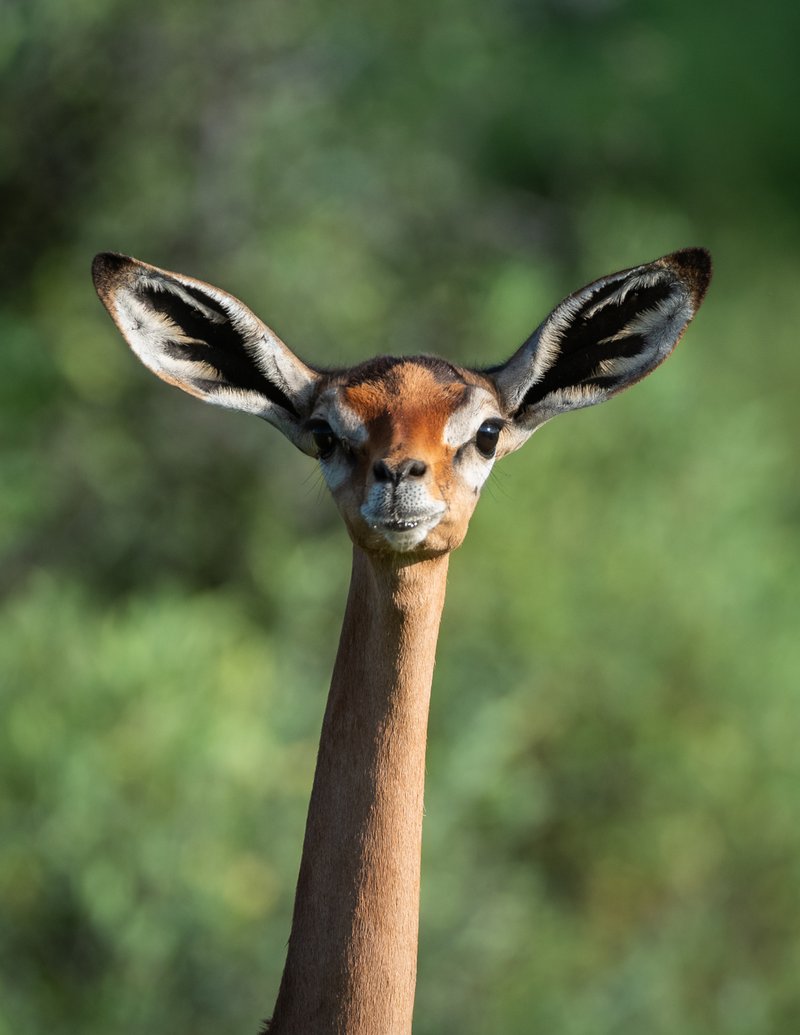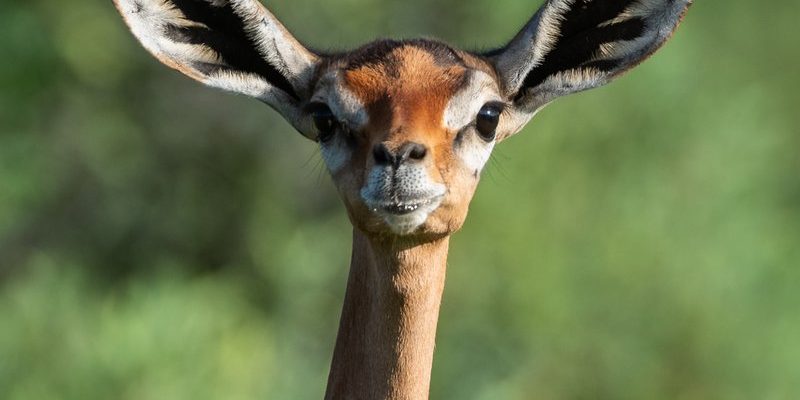
The gerenuk, often referred to as the “giraffe gazelle,” is more than just a pretty face. With its distinctive features and browsing habits, it has found its way into the stories and artistic expressions of the regions it inhabits. You might be wondering how an antelope can weave itself into the fabric of culture—let me explain. The gerenuk’s unique characteristics and behaviors have made it a captivating subject in folklore, art, and even conservation narratives.
The Gerenuk’s Unique Features and Significance
The gerenuk (Litocranius walleri) is quite the spectacle in the wild. Standing tall with its elongated neck, it can reach high branches that other herbivores can’t. This ability to browse in a niche that others cannot gives it an edge in survival. But it’s not just its physical attributes that make it special. Within the various cultures of East Africa, the gerenuk symbolizes adaptability, grace, and survival, traits that resonate deeply with people living in challenging environments.
In many cultures, animals often represent broader themes or morals. The gerenuk’s ability to thrive in arid landscapes serves as a metaphor for resilience. Imagine telling a group of children a story where a gerenuk outsmarts predators by using its height to see danger coming long before it’s close. This not only emphasizes cleverness but also showcases the importance of being aware of one’s surroundings.
Furthermore, the gerenuk’s unique mating rituals and social structures offer a window into social dynamics that can mirror human relationships. As it engages in courtship behaviors, like arching its neck and displaying its slender body, the gerenuk embodies the delicate balance of attraction and competition, much like us in the realm of love and friendships.
Folklore and Myths Surrounding the Gerenuk
Folktales often serve as vessels for cultural values and traditions. In some East African communities, the gerenuk has found its way into folk stories that convey essential life lessons. For example, one popular story tells of a clever gerenuk that helps other animals find water during a drought, illustrating the importance of community and sharing. In these narratives, the gerenuk isn’t just an animal; it’s a hero, inspiring others to work together in times of need.
In contrast, some tales highlight the gerenuk’s graceful movement and beauty, paralleling it to the elegant dances of local tribes. When performers mimic the gerenuk’s long strides and elegant pauses, it celebrates both the animal and the rich tradition of dance within the community. Stories and dances like these reinforce a connection to nature, emphasizing harmony between humans and wildlife.
Even in myths, the gerenuk’s unique traits are often exaggerated to convey moral lessons. If a gerenuk were to encounter a lion, the story might twist into a tale of clever escape, teaching listeners about the virtues of wisdom over brute strength. These stories remind listeners to think critically about challenges rather than relying solely on power or aggression.
Representations of the Gerenuk in Art
Art has a powerful way of reflecting cultural beliefs and traditions. You might find the gerenuk depicted in various forms of art, from traditional carvings to contemporary paintings. In many cases, these representations emphasize the animal’s beauty, grace, and connection to the land.
For instance, local artisans often carve sculptures of the gerenuk using wood or stone, showcasing its long neck and delicate features. These artworks can serve as talismans, believed to bring good luck or protection to the home. Each carving tells a story, connecting the viewer to the animal’s natural habitat and the broader narrative of survival in a harsh environment.
In modern art, the gerenuk can also be found in illustrations that highlight conservation efforts. Artists may portray the gerenuk in vibrant settings, calling attention to its dwindling habitat due to human activity. This not only raises awareness but also encourages a sense of responsibility towards protecting these beautiful creatures and their environments.
Moreover, social media has become a new canvas for cultural representation. You’ll find photographers and wildlife enthusiasts sharing stunning photos of the gerenuk, often accompanied by stories that highlight its plight and the importance of conservation. This digital storytelling bridges the gap between traditional folklore and contemporary environmental narratives.
The Gerenuk in Traditional Medicine and Beliefs
In some cultures, animal parts are believed to have medicinal properties or spiritual significance. The gerenuk is no exception. In specific communities, its bones or hides might be used in traditional medicine, believed to bring strength or health. However, it’s essential to approach this topic with respect for cultural practices and an understanding of conservation ethics.
Some tribes might incorporate the gerenuk into rituals, believing that the animal carries a spiritual essence that can bless the community. For instance, during ceremonies, a gathering might invoke the spirit of the gerenuk to ensure a good harvest or successful hunting season. These practices highlight the deep connection between the animal and the community, representing a shared respect for nature.
Conversely, as modernization spreads, many communities are re-evaluating these traditional beliefs. With conservation efforts gaining traction, some have begun to see the gerenuk not just as a source of material goods but as a keystone species vital to the ecosystem. This shift in perspective emphasizes the need to protect such animals rather than exploit them.
Conservation Efforts and the Gerenuk
As the gerenuk faces threats from habitat loss and poaching, conservation efforts have become crucial. Organizations and local communities are working together to protect these graceful antelopes, ensuring that future generations can enjoy their beauty as part of the natural world.
Education plays a significant role in these efforts. Programs that teach children about the gerenuk’s unique role in the ecosystem help foster appreciation and respect for wildlife. When kids learn about how the gerenuk impacts its environment, they’re more likely to advocate for its protection.
Moreover, local communities are often at the forefront of these conservation initiatives. By recognizing the gerenuk’s cultural significance, they can create programs that blend traditional knowledge with modern conservation techniques. It’s a win-win situation; communities benefit economically from wildlife tourism while ensuring the survival of the gerenuk and their habitats.
In some areas, ecotourism has become a successful vehicle for conservation. Tourists flock to see the gerenuk in its natural habitat, providing income that supports local communities and conservation projects. This creates a mutually beneficial relationship where both wildlife and humans can thrive.
The Gerenuk’s Role in Education and Awareness
As fascinating as the gerenuk is, there’s still so much to learn about this incredible creature. Educational programs in zoos and wildlife reserves often feature the gerenuk, shedding light on its behavior, diet, and habitat needs. These programs help dispel myths and raise awareness about the challenges the gerenuk faces.
Schools and community organizations are increasingly incorporating wildlife education into their curricula. Students might engage in projects about the gerenuk, learning not only about this particular animal but also about broader concepts of ecology and conservation. This grassroots approach can inspire a new generation of environmental stewards, equipped with the knowledge to make informed decisions about wildlife conservation.
Additionally, documentaries and nature programs featuring the gerenuk help reach wider audiences. By showcasing its unique features and the beauty of its habitat, filmmakers bring attention to the need for conservation in a compelling way. These visual narratives can evoke emotional responses, encouraging viewers to take action in support of wildlife protection.
Overall, the representation of the gerenuk in culture and folklore is rich and diverse, highlighting its importance in the ecosystems it inhabits. As communities continue to share stories and traditions, the gerenuk remains a symbol of adaptability, resilience, and the deep connection between humans and nature.
In wrapping up, the gerenuk is much more than just an antelope. It’s a symbol of grace and survival, woven into the fabric of the cultures that share its home. While challenges abound, the stories and representations of the gerenuk encourage us to foster appreciation and take action for wildlife conservation. So next time you see a picture of this elegant creature, take a moment to appreciate the stories it tells and the lessons it teaches about nature and resilience.

